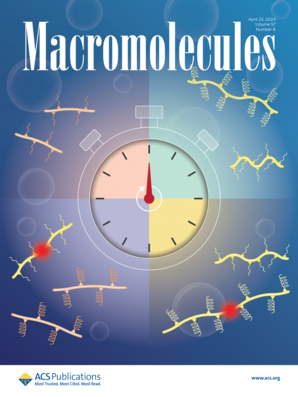离子液体在高压形成延伸链聚偏氟乙烯晶体中的双重作用:热力学和动力学的相互作用
IF 5.1
1区 化学
Q1 POLYMER SCIENCE
引用次数: 0
摘要
探索温和的高压工艺条件是开发基于极性延伸链晶体(ECCs)的耐热电活性聚偏氟乙烯(PVDF)材料的必要条件。本文介绍了一种典型的咪唑离子液体(IL), 1-乙基-3-甲基咪唑四氟硼酸盐,在高压下操纵PVDF的熔融结晶。我们的研究结果通过各种结构和形态特征揭示了IL在ECCs形成中的双重作用。首先,它通过提高末端表面的自由能σe来增加生长核的自由能,使得ECCs的形成在热力学上不利。其次,在细胞核生长过程中,它有利于链滑动扩散,降低扩散活化能,在动力学上促进了ECCs的生成。这两种效应相互竞争,受结晶条件和IL含量的影响。在低结晶温度(Tp)和低IL馏分下主要是动力学促进作用,而在高Tp和/或高IL馏分下主要是热力学抑制作用。PVDF/IL共混物的高压相图说明了这种相互作用。低IL分数(如0.2%)显著扩大ECCs生长区域,使其在较低Tp和压力条件下生长,而较高IL分数则具有相反的效果。这种知识使得在较温和的低温下以最少的IL添加快速制备丰富的ECCs,从而最大限度地减少样品降解。此外,il诱导的ECCs主要由极性β相组成,并保持较高的熔点。本研究阐明了PVDF/IL共混物的高压结晶机理,提出了提高PVDF均聚物极性ECCs产量的有效策略。本文章由计算机程序翻译,如有差异,请以英文原文为准。

Dual Role of Ionic Liquid in High-Pressure Formation of Extended-Chain Poly(vinylidene fluoride) Crystals: Interplay between Thermodynamics and Kinetics
Exploring milder high-pressure processing conditions is essential for developing heat-resistant electroactive poly(vinylidene fluoride) (PVDF) materials based on polar extended-chain crystals (ECCs). Herein, we introduced a typical imidazole ionic liquid (IL), 1-ethyl-3-methylimidazolium tetrafluoroborate, to manipulate the melt crystallization of PVDF under high pressure. Our findings reveal a dual role of IL in ECCs formation through various structural and morphological characterizations. First, it increases the free energy of growing nuclei by raising the end surface free energy σe, making ECCs formation thermodynamically unfavorable. Second, it facilitates chain sliding diffusion and lowers the diffusion activation energy during nuclei growth, which promotes ECCs generation in kinetics. These two effects compete with each other, influenced by crystallization conditions and IL content. Kinetic promotion prevails at low crystallization temperatures (Tp) and low IL fractions, while thermodynamic inhibition dominates at high Tp and/or high IL fractions. This interplay is illustrated by high-pressure phase diagrams of PVDF/IL blends. A low IL fraction (e.g., 0.2%) significantly expands the ECCs growth region into lower Tp and pressure conditions, while a higher IL fraction has the opposite effect. This knowledge enables the rapid preparation of abundant ECCs with minimal IL addition at milder low temperatures, thereby minimizing sample degradation. Furthermore, the IL-induced ECCs primarily consist of the polar β-phase and maintain a high melting point. This study elucidates the high-pressure crystallization mechanism of PVDF/IL blends and proposes an effective strategy for enhancing the production of polar ECCs in PVDF homopolymer.
求助全文
通过发布文献求助,成功后即可免费获取论文全文。
去求助
来源期刊

Macromolecules
工程技术-高分子科学
CiteScore
9.30
自引率
16.40%
发文量
942
审稿时长
2 months
期刊介绍:
Macromolecules publishes original, fundamental, and impactful research on all aspects of polymer science. Topics of interest include synthesis (e.g., controlled polymerizations, polymerization catalysis, post polymerization modification, new monomer structures and polymer architectures, and polymerization mechanisms/kinetics analysis); phase behavior, thermodynamics, dynamic, and ordering/disordering phenomena (e.g., self-assembly, gelation, crystallization, solution/melt/solid-state characteristics); structure and properties (e.g., mechanical and rheological properties, surface/interfacial characteristics, electronic and transport properties); new state of the art characterization (e.g., spectroscopy, scattering, microscopy, rheology), simulation (e.g., Monte Carlo, molecular dynamics, multi-scale/coarse-grained modeling), and theoretical methods. Renewable/sustainable polymers, polymer networks, responsive polymers, electro-, magneto- and opto-active macromolecules, inorganic polymers, charge-transporting polymers (ion-containing, semiconducting, and conducting), nanostructured polymers, and polymer composites are also of interest. Typical papers published in Macromolecules showcase important and innovative concepts, experimental methods/observations, and theoretical/computational approaches that demonstrate a fundamental advance in the understanding of polymers.
 求助内容:
求助内容: 应助结果提醒方式:
应助结果提醒方式:


